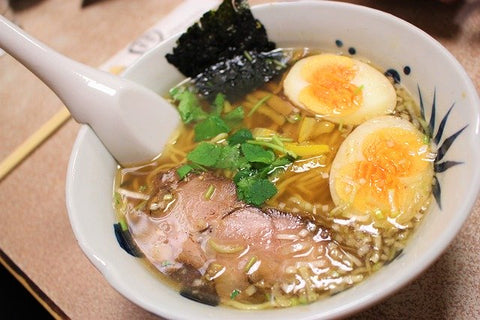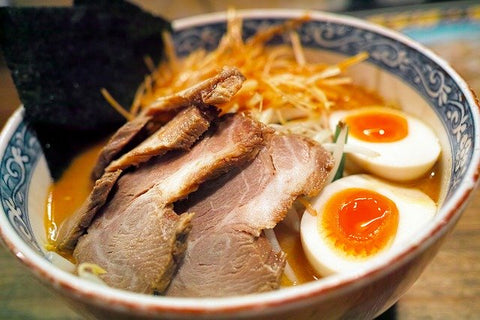
I think you already know, but ramen looks like this…

1. Exactly when you call a noodle dish "ramen" is..
Ramen is a Japanese soup noodle dish.
It consists of wheat noodles, soup, and toppings like soft boiled egg, pork BBQ, and green onions.

Noodles of ramen are shaped like long string pieces.

Some of them are straight and some of them are wavy.
And they have a nice bouncy chewiness.
Ramen noodles are made of wheat flour, water, and kansui.

Soup of ramen is made up of water and a combination of pork bone, beef bone, chicken, bonito, kelp, mushroom, dried sardine, or scallops.
Chefs boil the ingredients for a long time to make the umami soup rich.

2. Why you have to know the word ramen

1. It sounds foreign
Ramen is getting popular everywhere in the world...
Because of globalization of food and Japanese pop culture like anime.
Probably you’ve wondered what the word means exactly...
When you saw the word ramen on the sign at a restaurant, or the packaging of instant noodles.

2. You don't want to mess up the word "ramen"
In addition, you know there are other dishes that look similar to ramen.
They might be other Japanese noodle dishes, or noodle dishes that came from other different foreign countries.
So I have a quick quiz for you…

Can you pick out which one is ramen from the pictures below?







The answer is…
C
Could you name the other noodles dishes?
Here are the names of the other dishes from the pictures...
A: Chow mein
B: Soba
C: Tonkotsu ramen
D: Naengmyeon
E: Pho
F: Udon
G: Pad thai

3. The actual way of pronouncing ramen
In English, people pronounce ramen “raa-muhn”.
And in Japan, we pronounce it “rah-men”.

4. What are other different names for ramen?
In Japan, ramen is also called “shinasoba” and “chukasoba”.
They are older versions of names for ramen, so you might hear them from older people when you are in Japan.
But ramen is the most commonly used word there.
However:
Actually, there are some differences between ramen and chukasoba or shinasoba.
Chukasoba or shinasoba is a style of ramen that has light shoyu soup or shio soup.
Broth chukasoba and shinasoba are made of chicken bone and seafood.
It is the style of Tokyo shoyu ramen.
The older types of ramen.

And when you use the word chukasoba or shinasoba, usually you are talking about this style of ramen specifically.
Ramen is a broader umbrella term than chukasoba or shinasoba.
Calling newer types of ramen chukasoba or shinasoba is strange to me.

5. The unknown theories of why ramen is called ramen
There are 3 theories of the word origin of ramen.

Theory No. 1: Lamian
Ramen and Lamian,
They sound similar. Right?
Did you know?
The origin of ramen is from Chinese noodles,
And lamian is one of the prototypes of ramen.
That is why they sound similar, and lamian might be the root of the word ramen.
However,
Ramen and lamian are very different types of food, even though lamian was the basis for the creation of ramen.
In Chinese, "la" means "to pull" and "mian" is a food product made from wheat dough including noodles.
So, what this means is lamian is literally translated into hand-pulled noodles.
For ramen, you don't hand-pull the dough. You make the dough flat, and cut it into long, thin noodle-like strands.
Do you know Japanese people mix up the “L” and “R” sounds? (Sometimes I still have trouble with that!)
And that is why ramen is spelled with an “R” instead of an “L".
Let’s recap: Japanese ramen noodles is used to refer to the generic noodles made of wheat, while lamian refers specifically to hand-pulled Chinese noodles.

Theory No. 2: Laomian
Laomian is Chinese noodle that is another root of ramen.
Lao means old in Chinese.

Theory No. 3: Hao la
in 1922, Masaharu Ohisa and his wife Tatsu opened a restaurant called Takeya in Sapporo, Hokkaido.
He hired a Chinese chef for the kitchen, and the chef served noodles.
And when the chef finished cooking, he used to say “hao la!”
It meant that the food was ready.
Tatsu liked the sound of “hao la”.
She took the sound “la” and added the word “men” which meant noodles in Japanese.
And named the noodles they served ramen.
Again L and R.

If ramen or any other types of Japanese style noodles and soup is comfort food for you, you might be thinking that you need ramen bowls.
Ramen bowls are perfect for a large bowl of ramen.
They are big enough to pile on the fixings, they are durable, and best of all, they look beautiful.
Share a bowl of warm, hearty home cooked ramen with your family, friends and loved ones for your ramen night.
Or when you order take out, transfer the noodles from those awful looking containers.
You and your family will be so excited and can’t wait until your next ramen night to use these bowls!
About the Author

"I am from Ibaraki, Japan.
Ramen is great! It can bring you a sense of happiness and satisfaction that no other food can. I have been eating ramen for 30 years.
If there is no ramen, my life would be miserable.
Ten years ago, I worked as an office worker. The job was really stressful - excessive working hours, low wages, unpaid overtime work, and constantly being yelled at by my boss.
I was new and alone, no girlfriend, no friends, and felt very lonely.
My only oasis was the ramen shop near the office. For me, the ramen chef there was literally an angel. I saw a halo on his head. (No joke)
Tonkotsu shoyu ramen was my all-time favorite. He made ramen with broth chock-full of umami flavor, nice chewy handmade noodles, and tender chashu.
My greatest dream is connect people with ramen through my blog. I want to share a lot of interesting and funny stories and ramen trivia with you.
Knowing more about ramen can help you appreciate your ramen and make it taste extra delicious."
Is Ramen Considered Chinese Cuisine? 6 Facts You Should Know
Pronunciation of Ramen: Don't say the word 'till you read this
Origin of Ramen: If You Don't Read This Now, You'll Hate Yourself Later



Leave a comment